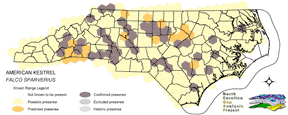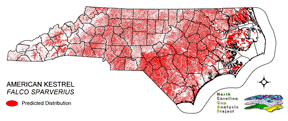
| Taxa: |
| Order: |
| Family: |
| Aves |
| Falconiformes |
| Falconidae |
| NatureServe Global Rank: |
| NatureServe State (NC) Rank: |
| G5 |
| S3B,S5N |
| Federal Status: |
| NC State Status: |
| --- |
| W1,W5 |


| Land Unit |
| US Fish & Wildlife Service |
| US Forest Service |
| US National Park Service |
| US Department of Defense |
| NC State Parks |
| NC University System |
| NC Wildlife Res. Com. |
| NC Forest Service |
| NC Div. of Coastal Mgmt. |
| Local Governments |
| Non-Governmental Org. |
| Other Public Lands |
| Private Lands |
| GAP Status 1-2 |
| All Protected Lands |
| Statewide |
| Hectares |
| 20,433.96 |
| 23,270.58 |
| 72,981.09 |
| 7,790.85 |
| 6,728.94 |
| 4,386.78 |
| 31,082.76 |
| 4,823.85 |
| 1,461.24 |
| 1,224.09 |
| 5,144.22 |
| 3,420.27 |
| 5,047,826.49 |
| 51,916.53 |
| 180,095.43 |
| 5,230,575.12 |
| Acres |
| 50,493.40 |
| 57,502.84 |
| 180,340.17 |
| 19,251.61 |
| 16,627.57 |
| 10,839.97 |
| 76,807.16 |
| 12,196.80 |
| 3,610.80 |
| 3,024.79 |
| 12,711.64 |
| 8,451.67 |
| 12,473,448.47 |
| 128,565.32 |
| 445,302.22 |
| 12,925,306.89 |
| % of Dist. on |
| Prot. Lands |
| 11.3 % |
| 12.9 % |
| 40.1 % |
| 4.3 % |
| 3.7 % |
| 2.4 % |
| 16.7 % |
| 2.7 % |
| 0.8 % |
| 2.8 % |
| 2.8 % |
| 1.5 % |
| < 0.1 % |
| 28.8 % |
| ----- |
| ----- |
| % of Dist. on |
| All Lands |
| 0.4 % |
| 0.4 % |
| 1.4 % |
| 0.1 % |
| 0.1 % |
| < 0.1 % |
| 0.6 % |
| < 0.1 % |
| < 0.1 % |
| < 0.1 % |
| < 0.1 % |
| < 0.1 % |
| 96.5 % |
| 1.0 % |
| ----- |
| ----- |
|
Uncommon in the mountains, and rare to absent over the rest of the state (Hamel 1992, Potter et al 1980). Inhabits open areas with scattered trees or telephone poles, such as in pastures, fields, and farmland (Hamel 1992, Simpson 1992). Along with elevated perches, and open terrain for hunting, available nesting sites are also required, such as tree cavities, earthen banks, occasionally birdhouses, and non-tree cavities or crevices (Johnsgard 1990). Commonly occur in urban and suburban areas, and have even nested in chimneys and drainpipes (Palmer 1988). Nests in tree cavities, natural or old woodpecker holes, nest boxes, nooks or crevices in building eaves or church steeples (Hamel 1992, Harrison 1975, Potter et al 1980). Forages from high perches in open country, such as plowed or grassy fields, savannas, roadsides, and woodland margins (Hamel 1992, Kaufman 1996). NATURE SERVE GLOBAL HABITAT COMMENTS: Open or partly open habitat; prairies, deserts, wooded streams, burned forest, cultivated lands and farmland with scattered trees, open woodland, along roads, sometimes in cities. In winter in Florida, Texas, and California, males use less open habitats than do females (Smallwood 1987, Palmer 1988). Nests in natural holes in trees, abandoned woodpecker holes, holes in buildings or cliffs, abandoned magpie nests, and similar sites. Readily uses nest-boxes, which may dramatically increase density of nesting pairs in some areas (may use boxes put up for wood duck or goldeneye). In western Venezuela, nest cavities tend to face into prevailing winds (Balgooyen 1990). Rarely returns to breed in vicinity where reared, but breeders tend to return to their previous territories (Palmer 1988). |
| Code | Name | Description | NC Natural Heritage Program Equivalent |
| 3 | Tidal Marsh | Fresh and brackish tidal marshes, including cord grass, wild rice, sawgrass and needlerush alliances. | Brackish Marsh, Interdune pond, Maritime wet grassland |
| 371 | Maritime Grasslands | Dune grass community consisting of sea oats and beach grasses. | Dune grass, Maritime dry grassland |
| 97 | Mesic Longleaf Pine | Longleaf pine woodlands without a major scrub oak component. Slash or loblolly pines may be present as well. | Mesic Pine Flatwoods |
| 42 | Xeric Longleaf Pine | Sandhills including a range of longleaf pine density from predominantly wiregrass, scrub oak dominated to true longleaf pine woodland. This does not include mesic or saturated flatwood types. | Xeric Sandhill Scrub, Pine/Scrub Oak Sandhill, Coastal Fringe Sandhill |
| 46 | Xeric Oak - Pine Forests | Mixed forest dominated by yellow pines with white or northern red oaks co-dominating. | Pine Oak Heath |
| 226 | Piedmont Xeric Woodlands | Generally post and blackjack oak dominated woodlands. White ash and pignut hickory can be found in combination with Eastern red cedar on glades. | Xeric Hardpan Forest |
| 20 | Coniferous Regeneration | Regenerating pine stands. Predominantly loblolly pine, but slash and longleaf stands occur as well. | No equivalent |
| 36 | Successional Deciduous Forests | Regenerating deciduous trees with a shrub stature. Commonly dominated by sweetgum, tulip poplars and maples. | No equivalent |
| 180 | Agricultural Crop Fields | Farm fields used for row crops. | No equivalent |
| 205 | Agricultural Pasture/Hay and Natural Herbaceous | Farm fields used for pasture grass or hay production, as well as old fields dominated by native and exotic grasses. | No equivalent |
| 202 | Residential Urban | Includes vegetation interspersed in residential areas. Includes lawns, mixed species woodlots, and horticultural shrubs. Vegetation accounts for between 20 - 70% of the cover. | No equivalent |
| 203 | Urban Low-Intensity Developed | Highly developed areas with vegetation accounting for < 20% of the cover. | No equivalent |
|
Cruz, A. 1976. Food and foraging ecology of the American kestrel in Jamaica. Condor 78:409-412.
Titus, K., and M. R. Fuller. 1990. Recent trends in counts of migrant hawks from northeastern North America. Journal of Wildlife Management 54:463-470. Varland, D. E., and T. M. Loughlin. 1993. Reproductive success of American kestrels nesting along an interstate highway in central Iowa. Wilson Bull. 105:465-474. Kirk, D.A., D. Hussell, and E. Dunn. 1994/95. Raptor population status and trends in Canada. Bird Trends (Canadian Wildlife Service) 4:2-9. Hamel, P. B. 1992. The land manager's guide to the birds of the south. The Nature Conservancy, Chapel Hill, North Carolina. 367 pp + several appendices. Simpson MB Jr. 1992. Birds of the Blue Ridge Mountains. Chapel Hill and London: University of North Carolina Press. Fisher, A.K. 1893. The hawks and owls of the United States in their relation to agriculture. Washington U.S. Dept. of Agriculture Bull. no. 6. 210 pp. Kaufman K. 1996. Lives of North American Birds. Boston, New York: Houghton Mifflin Company. Balgooyen, T. G. 1989. Natural history of the American kestrel in Venezuela. J. Raptor Res. 23:85-93. Olsen, P.D., R.C. Marshall, and A. Gaal. 1989. Relationships within the genus FALCO:a comparison of the electrophoretic patterns of feather proteins. Emu 89:193-203. Balgooyen, T. G. 1990. Orientation of American kestrel nest cavities:revisited. J. Raptor Res. 24:27-28. Bednarz, J. C., D. Klem Jr., L. J. Goodrich, and S. E. Senner. 1990. Migration counts of raptors at Hawk Mountain, Pennsylvania, as indicators of population trends, 1934-1986. The Auk 107:96-109. Bureau of Land Management. Life History Summaries. Godfrey, W.E. 1966. The birds of Canada. National Museums of Canada. Ottawa. 428 pp. Balgooyen, T. G. 1976. Behavior and ecology of the American kestrel in the Sierra Nevada of California. Univ. California Publ. Zool. 83 pp. Harrison, C. 1978. A field guide to the nests, eggs and nestlings of North American birds. Collins, Cleveland, Ohio. Potter, E. F., J. F. Parnell, and R. P. Teulings. 1980. Birds of the Carolinas. Univ. North Carolina Press, Chapel Hill. 408 pp. Terres, J.K. 1980. The Audubon Society encyclopedia of North American birds. Alfred A. Knopf, New York. Raphael, M. G. 1985. Orientation of American kestrel nest cavities and nest trees. Condor 87:437-438. Cade, T.J. 1982. The falcons of the world. Cornell University Press, Ithaca, NY. 192 pp. Toland, B. R. 1985. Double brooding by American kestrels in central Missouri. Condor 87:434-436. Raffaele, H.A. 1983. A guide to the birds of Puerto Rico and the Virgin Islands. Fondo Educativo Interamericano, San Juan, Puerto Rico. 255 pp. Hilty, S.L., and W.L. Brown. 1986. A guide to the birds of Colombia. Princeton University Press, Princeton, New Jersey. 836 pp. Pendleton, B. A. Giron, et al. 1987. Raptor management techniques manual. National Wildlife Federation, Sci. and Tech. Ser. No. 10. 420 pp. Palmer, R. S., ed. 1988. Handbook of North American birds. Vol. 5. Yale Univ. Press, New Haven. 465 pp. Root, T. 1988. Atlas of wintering North American birds:An analysis of Christmas Bird Count data. University of Chicago Press. 336 pp. Smallwood, J. A. 1987. Sexual segregation by habitat in American kestrels wintering in southcentral Florida:vegeta-tive structure and responses to differential prey availability. Condor 89:842-849. Stiles, F.G., and A.F. Skutch. 1989. A guide to the birds of Costa Rica. Comstock Publ. Associates, Cornell University Press, Ithaca, New York. 511 pp. Johnsgard, P.A. 1990. Hawks, eagles, and falcons of North America. Smithsonian Inst. Press, Washington, D.C. xvi + 403 pp. |
For more information please contact them at:
NC-GAP Analysis Project
Dept. of Zoology, NCSU
Campus Box 7617
Raleigh, NC 27695-7617
(919) 513-2853
www.basic.ncsu.edu/ncgap